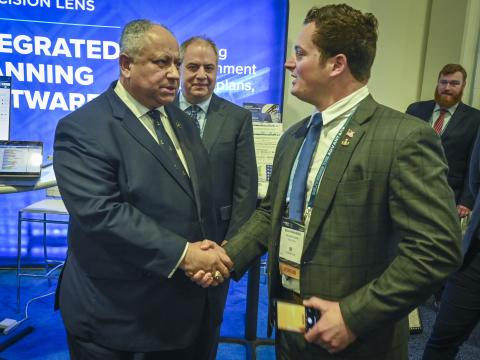Slowing Down Rapid Acquisition
With the war in Afghanistan winding down, the U.S. Defense Department’s rapid deployment office, which specializes in identifying, developing and quickly fielding game-changing technologies, now will take a more long-term approach. Slightly stretching out the process will offer more flexibility to procure the best possible systems, will present more opportunities for interagency and international cooperation and may cut costs.
Rather than looking for solutions the warfighters need immediately, office personnel will investigate technologies that will be needed up to five years away, or for technologies that will fill a gap or provide a hedge over potential adversaries. “The mission will evolve from a short-term focus to get the capability out and address time-sensitive warfighter needs to a mission of emerging capabilities,” reveals Earl Wyatt, deputy assistant secretary of defense, emerging capabilities and prototyping, Office of the Assistant Secretary of Defense for Research and Engineering. “It’s really about going from a zero- to 24-month focus to maybe a 36- to 60-month focus looking further out.”
The longer-term approach will provide several benefits, officials say. “We’ll be able to take a little bit more time. In some circumstances, it gives us an opportunity to identify a medium-risk or a lower-risk option and to give the warfighter or the senior leadership some more choices to pursue a particular course of action,” Wyatt offers.
The evolution also might save money. “The other part that comes into play is that we can focus a little more on affordability. We may do a demonstration and prove that a concept works, but we may want to spend a little more time on reducing the cost,” Wyatt says.
Furthermore, it might offer greater opportunities for interagency and international cooperation, something the office already does. “On the interagency side, we have for many, many years worked with other agencies, including the Department of Homeland Security, Department of Justice, Department of State and the intel community,” says Ben Riley, Wyatt’s principal deputy. “There are a couple of payoffs there. One is that you can help to defray the cost amongst agencies on the development of a specific capability. The other one is that agencies may look at a system from an entirely different perspective and use the capability in a totally different way.”
On the international side, Riley says, officials seek out mature capabilities that U.S. forces can use, defraying the cost of development. “We have a number of ongoing initiatives with allies in the Asian theater, Europe, Canada and South Africa,” he reports.
The new approach likely will include an emphasis on prototype development. “As we find ourselves in a more budget-constrained environment, you’ll see the department—and our office in particular—moving toward doing developmental prototypes before we make the commitment,” Wyatt reveals.
In some cases, the department might build a prototype and “put it on a shelf” until “the threat becomes imminent,” or until other circumstances require officials to procure the system. “You will find offices like ours concentrating on the art of the possible, on the potential threat, on how to maybe provide a hedge against that threat, or on the means upon which we can introduce new technology more affordably. And we’ll be using the instrument of a prototype more frequently than major acquisition programs, initiations or start-ups,” Wyatt says.
Besides demonstrating that a particular technical hurdle can be cleared, prototypes stimulate interest within the department and can preserve unique expertise that the Defense Department may need in the future, Wyatt says.
Wyatt and Riley cite the Accelerated Nuclear DNA Equipment (ANDE) system as one prototype already successfully developed. ANDE is about the size of a desktop printer and can generate DNA results in a fraction of the normal processing time. Usually, DNA samples are sent to a laboratory for processing. The laboratories often have a backlog, meaning it can take hours, if not days or weeks, to receive results. ANDE can process five samples in about 90 minutes. “Another value is the reduction of infrastructure in terms of the required DNA equipment,” Riley points out. “You reduce the logistics chain in terms of the storage of the materials and the chemicals that you need to do that kind of analysis.”
The rapid fielding office worked with the Joint Improvised Explosive Device Defeat Organization, the FBI and the Homeland Security Department. “Each of those agencies now has prototypes of that equipment, which it’s testing out, and each of them has a different use and application,” Wyatt adds. “Another thing I like about the program is that it was really the first-to-market of a field-portable DNA analysis capability. It certainly has stimulated the marketplace, and there are now a number of vendors and research centers developing competing capabilities, which may surpass what we have or may make what we have better in the long run.”
Wyatt also cites the Persistent Ground Surveillance System, an aerostat loaded with sensors that proved pivotal in Afghanistan. “That system was demonstrated by our office and then deployed to some 65 forward operating bases in Afghanistan. Whenever those balloons were aloft, the Taliban stayed away from the forward operating base, and even when they tried to shoot down the balloon, they could not,” Wyatt states.
The rapid fielding office also played a role in developing the unmanned aerial vehicle (UAV) hydrogen fuel cell that the Navy used last year to launch an unmanned plane from a submerged submarine. The idea originated when the rapid fielding office was working with the Naval Research Laboratory’s chemistry department, Wyatt reports. “Today, that capability to launch a UAV with a hydrogen fuel cell is pretty mature,” he says.
Also last year, the rapid fielding office concluded the NexTech project to identify what potential game-changing technologies currently exist but are not yet widely recognized as changing the world. NexTech included a series of war games with the U.S. Army War College, Naval Postgraduate School and U.S. Naval Academy. “We came out with a list of five technologies we think are game-changing. Other people might have a different list. Our objective was not to say this is the authoritative list on game-changing technologies, but rather these are some key areas,” Riley recalls.
Those five key areas are: additive manufacturing, more commonly referred to as 3-D printing; autonomous systems; directed energy; cyber capabilities; and human performance modification, which includes the use of drugs, techniques, machines or genes to enhance or degrade human performance. NexTech examined how U.S. forces and potential adversaries might use those technologies in 2025 or 2030.
A report on NexTech states that additive manufacturing could significantly alter logistics by allowing deployed units to print specific parts from available materials. It also could allow new approaches to tactical adaptation of equipment, as already seen in Afghanistan, where the rapid equipping force has deployed mobile labs to make improvements to everything from flashlights to power attachments for ground-penetrating radar.
In the years to come, the report points out, the United States will not be the only beneficiary of unmanned vehicles and may well be targeted by them. Autonomous systems are, therefore, likely to be an area of intense competition in the near term, meaning that the speed of deployment will be crucial for gaining or maintaining the advantage.
While directed-energy weapons may be limited by bad weather and other harsh conditions, they provide an opportunity to both generate game-changing advantages and improve defenses against the disruptive technologies of adversaries, the report concludes. In the cyber realm, the Internet of things—connectivity between countless small electronic devices that allows the creation of autonomous networks sharing information on users’ behalf—could potentially create disruptive alterations to current concepts of persistent intelligence, surveillance and reconnaissance and enable large-scale management of autonomous systems. Human performance modification could be used to enhance intelligence or night vision. Other biological and genetic technologies provide the opportunity for intelligence gathering based on genetic profiles; conducting tag, track and locate missions using bio-markers; or even assassinating high-value targets through custom-designed viruses. While these technologies may not yet be available, they are no longer in the realm of science fiction, the report states.
For the coming months or years, Wyatt’s priorities include autonomous systems. “We’re trying to see how, as the services draw down, we can provide certain capabilities that require less manpower. If I can reduce the number of boots on the ground, I reduce a lot of things in terms of cost of operations,” Wyatt explains.
Other priorities include space—for precision, navigation and timing capabilities as well as communication and battlespace awareness. “We want to make sure that the department can continue to operate in those domains. If an adversary tries to take it away from us, we want to provide a certain degree of resilience,” Wyatt adds.
Spectrum management and countering weapons of mass destruction also are high on the list. The rapid fielding office is examining the use of chemical weapons in Syria and the implications for the future warfighter. “That’s one that occupies a lot of my time,” Riley states. “If you ask me for a good conclusion, I don’t have any yet, but I can tell you that it’s a work in progress.”
The NexTech project indicated that a congruence of events must come together to make a given technology a game-changer, and it sometimes can take years for a system—such as an unmanned aerial vehicle—to really make a difference. Furthermore, no system will remain disruptive forever. “A game-changing technology is really game-changing for a finite period of time. Ultimately, your opponent will figure out how to counter that thing or develop the same kind of capability. It gives you an advantage, but only for a short period of time,” Riley maintains.





